All right… let’s go, more Umineko. We now embark on chapter 2, Ange and Maria.
Before that, though, let me quote a very interesting comment received by a reader named Gabriulio on episode 3, part 21!
To answer your question regarding “Rokkenjimagate,” the original Japanese name for it is 六軒島大量殺人事件. From what little research I could find, Japan tends to use 事件 in a similar fashion to -gate, so the localization feels appropriate to me, despite it not being the only use of 事件.
This is very interesting! So to break this down a bit, it comes out as
- 六軒島
- Rokkenjima
- 大量殺人
- mass murder, bloodbath
- 事件
- affair, incident, scandal, case, event
Now you mention it, this is a useful thing to know! Japanese history has a lot of ‘incidents’, and now I know what word is being translated in each case. So here is an assortment of previous jikens I know about…
Events which have earned the suffix '-jiken'
In chronological order…
- the Akō incident, (赤穂事件) in 1702, a highly mythologised incident in which 47 samurai (known as the forty-seven rōnin, 四十七士) who served Daimyō Asano Naganori took revenge for his execution-by-seppuku by assassinating the official who ordered it, even though they would also be obliged to kill themselves afterwards. Their story became a popular theme for fiction, a subgenre termed 忠臣蔵.
- the League of Blood Incident (血盟団事件) in 1932, in which a group of far-right extremists attempted to assassinate twenty businessmen and liberal politicians, but only killed two in the end.
- the February 26 Incident (二・二六事件) in 1936, in which a group of far-right officers of the 皇道派 or Imperial Way Faction attempted to stage a coup by assassinating politicians. Their attempt failed, the leaders of the group were executed, and their rival ‘moderate’ 統制派 or Control Faction took over (though to be clear when we say ‘moderate’, they were both fascists and this was only a few years before all the atrocities of WWII, so it’s a relative thing.)
- the Sada Abe Incident (阿部定事件) in which a sex worker strangled her lover during sex, and carried his testicles around. This event became a fascination of the pre-war ero guro nansensu movement. This later featured in two 70s films by Noboru Tanaka (A Woman Called Sada Abe, 1975) and Nagisa Ōshima (In The Realm of the Senses (1976), see Toku Tuesday 33).
- the Yodogō Hijacking Incident (よど号ハイジャック事件), in which members of the Japan Communist League took control of an aeroplane while shouting ‘We are Ashita no Joe!’, in reference to the boxing manga (see Animation Night 95). This one’s probably the most ‘fun’—nobody died thanks to a series of hostage exchanges, and there are wild turns like the government attempting to pass off a South Korean airport as North Korean. Most of the group were still alive in North Korea as of 2004.
- the Mishima incident (三島事件) in 1970, in which the popular, suicide-fascinated far-right author Yukio Mishima and some of his cronies attacked a military base and gave a speech trying to provoke a coup by the JSDF, before Mishima and one other themselves by seppuku in the commandant’s office. This was later portrayed in the film Mishima: A Life in Four Chapters (1985) by Paul Schrader.
- the Asama-Sansō incident (あさま山荘事件) in 1972 in which members of the Maoist militant group the United Red Army (連合赤軍) fled into the mountains after a series of robberies only for their leaders to start an internal purge for ‘self-crit’ reasons that killed most of the group through beatings and exposure. The survivors were eventually arrested after an extended police siege; four were sentenced to life in prison and one to death, although he has not yet been executed.
- the Tsutomu Miyazaki incident, or Tokyo/Saitama Serial Kidnapping Murders of Little Girls (東京・埼玉連続幼女誘拐殺人事件), in which serial killer Tsutomu Miyazaki murdered and raped the bodies of four young girls aged four to seven. The media claimed he had a collection of lolicon anime and manga, dubbing him the ‘otaku killer’, which led to a severe backlash against the otaku subculture and the abrupt end of the ‘lolicon boom’ of the 80s, giving way to 90s-onwards ‘moe’ designs in anime and manga.
- the Tokyo subway sarin attacks (地下鉄サリン事件) in 1995, in which members of the far-right doomsday cult Aum Shinrikyo attacked passengers on the subway with nerve gas.
Such incidents are the background to the second season of Ghost in the Shell: Stand Alone Complex.
Also, if you’re wondering, the Japanese for the actual Watergate scandal is indeed ウォーターゲート事件.
So a typical literal translation would go ‘Rokkenjima Mass-murder Incident’, but ‘Rokkenjimagate’ is definitely snappier! Thank you so much for providing the Japanese, that’s a great connection to be able to make.
Gabriulio also comments…
One last thing I’d like to comment on EP3, which kinda borders on meta trivia, is how the original plan for the Episode ended up being completely different from the version we got. Long story short, Ryukishi07 has admitted to lurking on message boards between Episode releases to gauge the fans’ reception to his work and adjust things accordingly.
The original plan was for EP3 to be called “Land of the Golden Witch” and it was already halfway written when he realized that the fans were not engaging with the story in the way he intended, so he scrapped Land and wrote Banquet from scratch. When this was first announced, many people were worried that he wasn’t going to finish things in time for that year’s Comiket. Thankfully he pulled through, but I can only imagine how bad that crunch must have been.
Oh, this is interesting. I wonder what the original plan would have been! And for that matter, what his problem was with the fan engagement. Big oof to have written such a long complex visual novel in such a short time, and have it read so well on top. My awe for Ryuukishi-san grows.
Anyway, on to the actual chapter. We see Ange’s school uniform, which I imagine she must have gotten tailored to get the waist that tight…
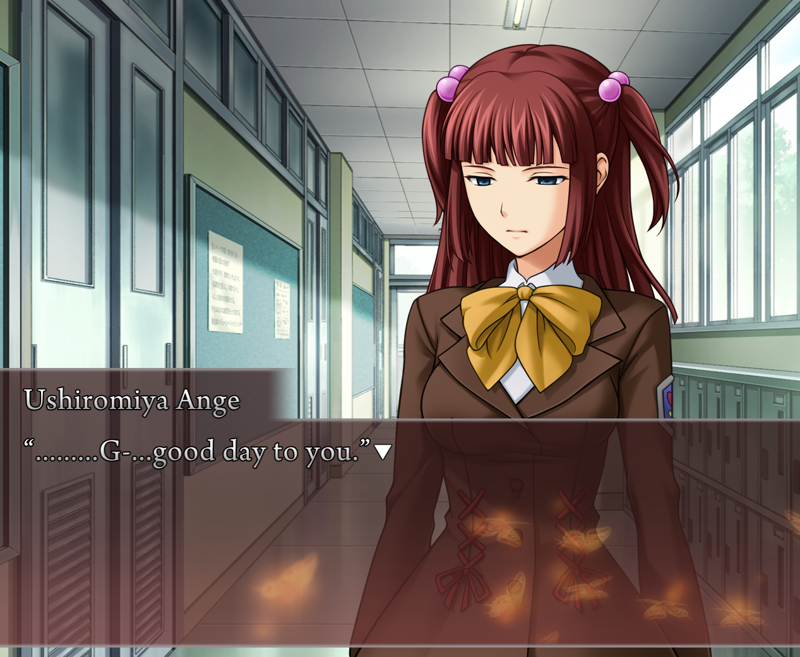
In this school, the standard greeting is ごきげんよう, which the game translates as ‘good day to you’. It seems to be a lot more rare than the more standard 今日は, and Ange stumbles over it.
We learn the name of the school is Saint Lucia Academy, and much as we heard before, Ange is isolated and unpopular. It’s a hidden private school only known to super-rich celebrities. She is not the only student who’s sent there as essentially a prisoner, to be hidden away and not allowed outside. The depressed appearance of such students has become recognisable, making them pariahs.
In a classroom that has more of the look of a lecture hall, the ‘Class Leader’ comes up to talk to her, with a sneer. It turns out she’s neglected a questionnaire for the ‘class presentation’—a trap set up by not giving her one in the first place. The other girls in the class aren’t illustrated, but the voice actors certainly convey how snooty they are. But the bullying does not particularly get to ‘Ushiromiya-san’, because her guardian is of course Eva…
The narration flashes back to when she heard about the murders. Ange had hoped to live with her maternal grandfather, but Eva applied all the force of, well, Ushiromiya Eva to insist on being her guardian and Ange didn’t really get a say in it.
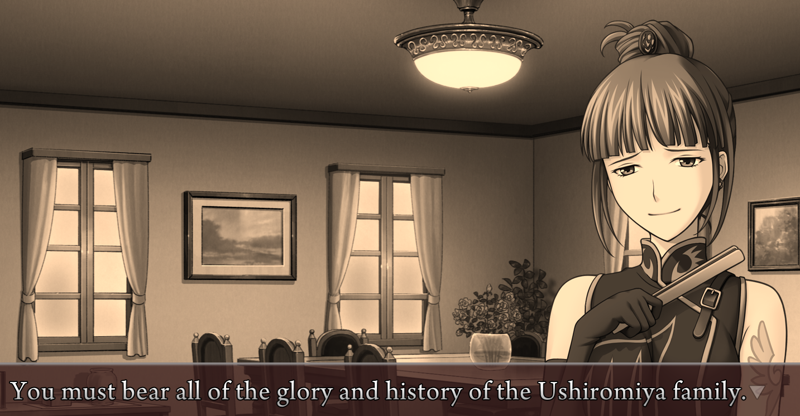
Eva immediately set about attempting to precisely replicate her own childhood trauma that we saw in the last episode. But really it’s just an excuses to lambast and abuse Ange for failing to be George. After a certain amount of this, Ange attempted to flee. It did not go well…
I was caught by the guards and brought back, ………and for being a coward who had disgraced the Ushiromiya family crest and attempted to abandon the Ushiromiya name, ………I was punished, ………in a way that makes my whole body shake and shiver just remembering it.
Which is to say, Eva let out all of her sadism, presumably into kicking the shit out of her (I’d prefer not to imagine anything else). Of course, it’s not really about the Ushiromiya name, but it makes me think of the idea of sacrifice. If thousands of soldiers can be sent to kill and die in the name of a country, that country must be more important than all those lives. And if a child can be beaten for the sake of ‘the Ushiromiya name’, then the Ushiromiya name is more important than the wellbeing of children.
So after surveillance and abuse from age 6 onwards, the class’s bullying is relatively easy to tank. Still, in such circumstances, she very unsderstandably prefers to be alone. And when she’s alone… she reads Maria’s diary!
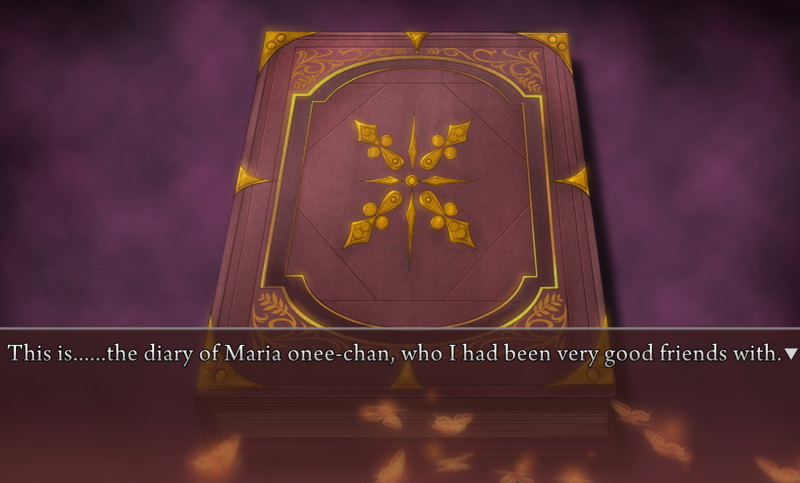
Maria’s diary is written like ‘a letter to another Maria’, and is very detailed. And Ange thinks of Maria as her only friend… T_T
This is represented by a CG:
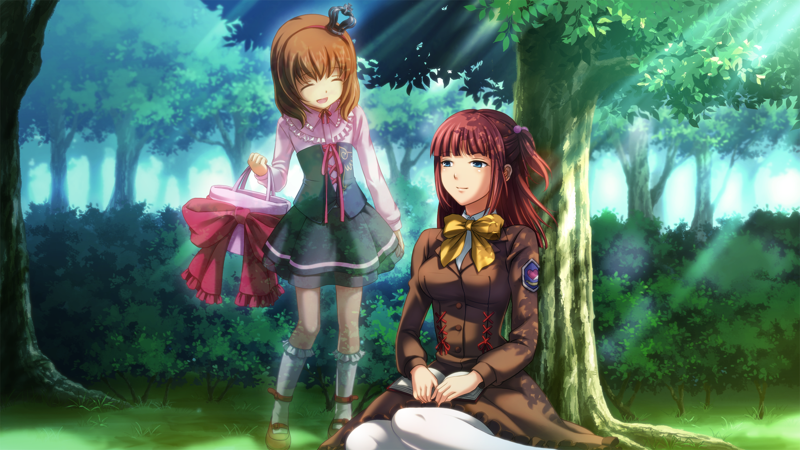
Ange has become a kind of imaginary friend, with whom she has a conversation. (I don’t know if we should think of this Maria as an introject alter? With Ange’s life, DID wouldn’t exactly be surprising mind you…) So in this way, Maria through the diary tells Ange about her plush Sakutoro, and we cut to a flashback-within-a-flashback in which Rosa and Maria went to a diner for Maria’s birthday.
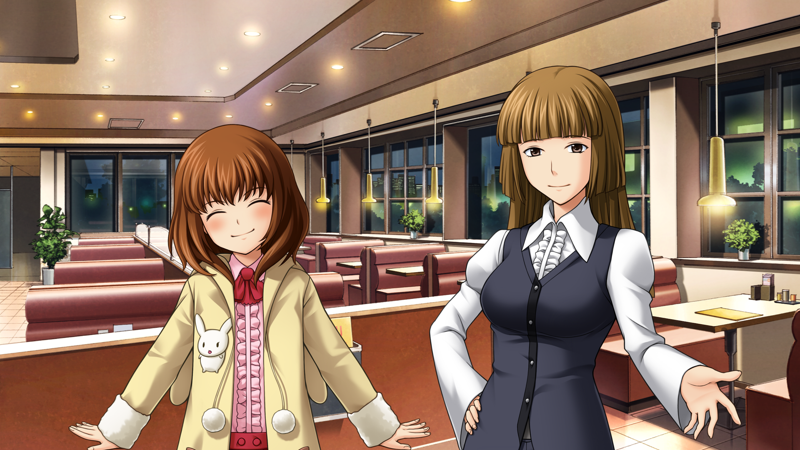
This results in new outfits for both Maria and Rosa. Maria gets a cute rabbit coat and Rosa gets to go all office lady. For such a young girl, Maria is pretty conscious of the price of food, noting when the pizza she wants is 200 yen more than the usual order! In any case, Rosa dotes on Maria, much to her delight. The narration clarifies that usually Rosa would take her somewhere more upscale, but had to cancel her reservation for work.
This prompts Ange to think back to her own birthdays. Rudolf would make a point of coming home briefly from work, and Kyrie would be an expert present-giver. Honestly, of all the Ushiromiya parents, they seem to be easily the most chill. Battler would show up only sometimes, still angry with Rudolf. Maria peeks into Ange’s memories here.
I do wonder if this ghost Maria is going to become an active character on the ‘magic side’ like Eva Beatrice.
Anyway, this birthday is when Maria was presented with Sakutaro, a lion hand-made by Rosa. And, omg, we learn that her clothing company was called <Auntie Rosa>, in English. ‘Sakutarō’ is a masculinised version of the common name ‘Sakura’, and it later got shortened to just ‘Sakutaro’.
Maria says Sakura is the main character in an anime she likes… wonder if we can figure out which one? This is presumably just one or two years before Rokkemjimagate since the appearance of Maria and Rosa is pretty much as we know them. The obvious pick, given Maria’s enthusiasm for magical girl anime, might be the Cardcaptor Sakura (1996-2000), but that’s too late. Actually, the magical girl genre was really only getting started in the 80s with titles like Magical Princess Minky Momo (1982-87) and Creamy Mami, the Magical Angel (1983-86).
After scouring MyAnimeList’s database, about the only candidate I hit was Esper Mami (1977-83) whose MC is Sakura Mami, but I have no idea if this is popular enough to count. And there is a Sakura in Urusei Yatsura, although she’s a secondary character and I don’t know if Maria would watch that. Of course, it’s entirely possible that Ryuukishi07 just made this up!
It’s not like it’s, uh, important or anything.
OK, I asked some friends, and onoe of them looked up—apparently we’ll later learn that this is a parody of Cardcaptor Sakura called Card Master Sakura. The design of Sakutaro (which we’ll see shortly) is a riff on Sakura’s companion Kero-chan.
Even on her daughter’s birthday, Rosa is still very caught up in propriety, repeatedly telling her not to make a scene. Anyway, Sakutaro, when he finally appears, earns a change of music and a full scale CGI. I guess this isn’t just a cute scene, huh. This is going somewhere.
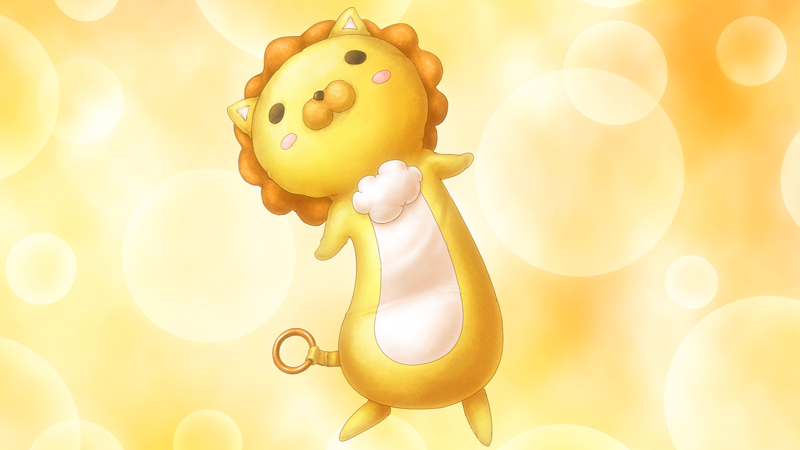
Even if it’s just a line of Umineko merchandise. I would not be surprised if they started selling a run of Sakutaros at comiket.
To really drive home the importance of this lion, we get another CG of Rosa passing it to Maria…
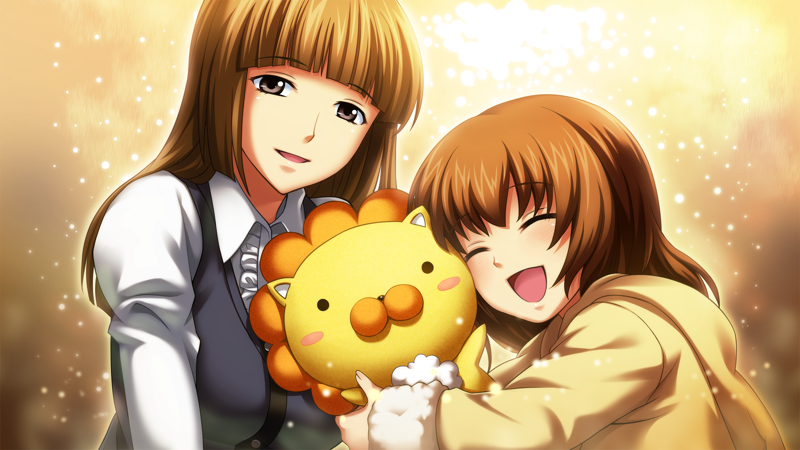
I know the PS3 version’s use of CGIs is not overseen by Ryuukishi07, but all the same: predicting now that Sakutaro will be talking by the end of the episode.
Rosa indulges in the bad habit of the artist and self-deprecates, but Maria is over the moon. In this flashback’s version of a ‘meta’ world, she eagerly tells Ange about Sakutaro’s playful personality. Much like Ange, she indicates she’s all alone at school and her mother is always at work. Like Ange, she’s bullied and treated as unclean by her classmates—this time fixating on her occult interests and, let’s be real, her autism.
Ange scoffs at how little humans have changed in a decade. ‘Go extinct already.’ Maria meanwhile has a fatalist attitude: every class must have a bullying victim.
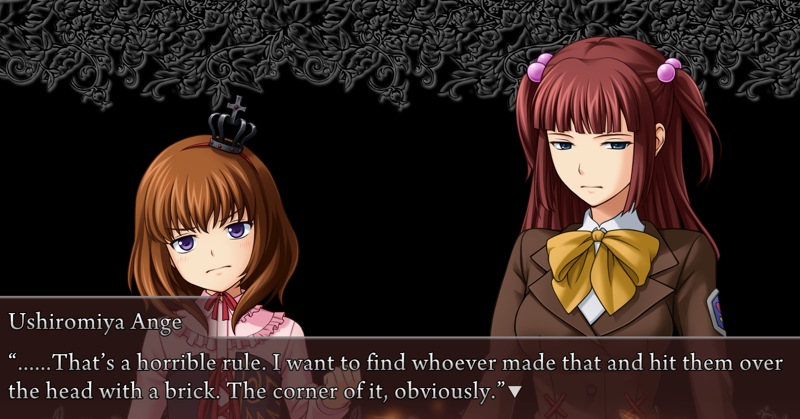
I like Ange.
Anyway, Maria sees herself as a protector of whoever would get bullied in her stead. Oof, where have I heard that sort of attitude before? Just about all my friends? Mm, yeah. Witches come up: according to Maria, anywhere people gather will have a witch who wants people to die so ‘she’ can steal their souls, or to become corrupted and evil.
But one day, Maria declares, an angel came, and fought the witch over seven days and seven nights. Not beaten but certainly exhausted, the witch proposed a truce… so far only half the class were sacrificed, and the remaining half were protected. But the witch is willing to go down to one victim, and protect everyone else.
So a micro-Omelas in essence.
The (seemingly utilitarian) angel agreed, for the sake of the extra 19 who would be saved and protected. Hmm, 19, that’s an interesting number. So Maria sees herself as a sacrifice for the sake of the witch protecting those 19. Ange is, understandably, not impressed by the idea that her bullying is for the good health of her bullies.
Sakutaro does indeed speak, although there is no talksprite just yet.
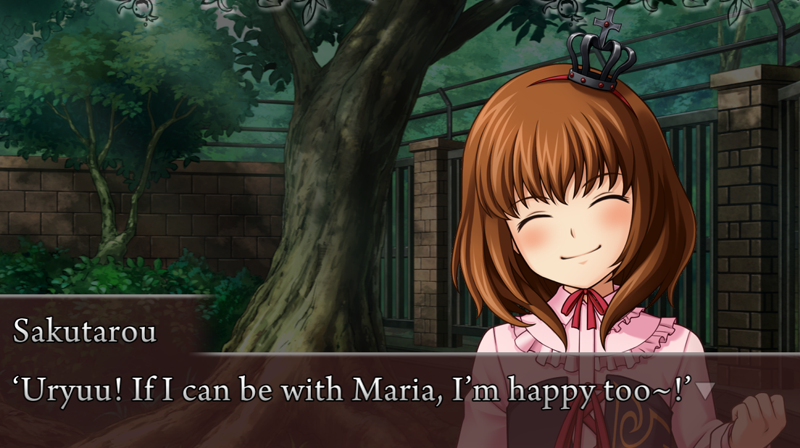
But it is in fact just Maria putting on a funny voice.
For Ange, this is all quite hard to understand, but she wants to achieve Maria’s peace of mind… Maria proposes that Sakutaro should become Ange’s friend as well, and acts him out.
Sakutaro is kind of timid, and says ‘Uryu’ a lot. Maria has him introduce himself to Ange. We don’t get a talksprite still, but we do alternate two views of Sakutaro’s CG. Ange thinks about how much personality and love Maria has imbued into him, and that he is definitely a friend…
At that point an old-timey phone rings! Huh. Oh, we’re back into the flashback. Rosa is calling Maria from work late at night, sleeping at the office. Anime studio hours then.
We get a look at Maria’s room… much as you might imagine, with a mother who dotes on her by buying shit as a perpetual apology for not being around (and worse treatment), it’s packed full of plushies.
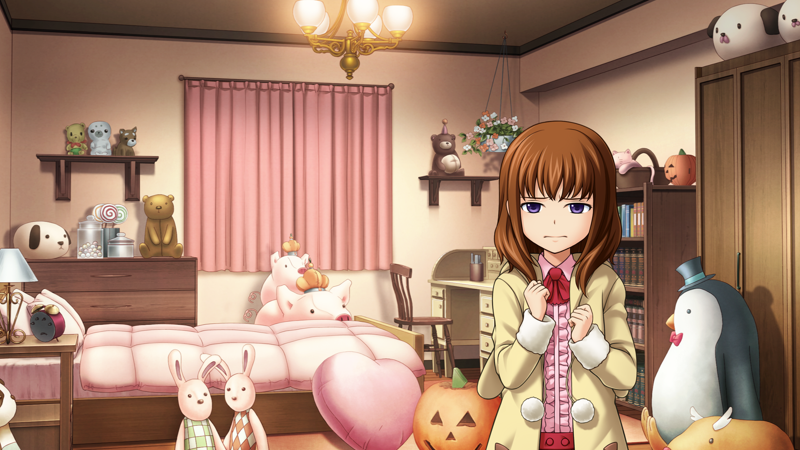
Rosa forbids Maria taking Sakutaro out to the shops with her, and Maria roleplays a conversation with Sakutaro about this order. She comes up with the idea of putting Sakutaro in a knapsack. In the meta, Maria eagerly tells Ange how Sakutaro would help and protect her.
OK, I think I know where this is going. Witches’ ‘furniture’, right. Do you reckon this is how it starts?
Anyway, Maria says that with Ange’s weak magic, she can only perceive these two when the diary is open—like the wind, visible only in its effect on things like smoke. So now Ange is a Beatrice, will that mean..?
Maria declares that she left a fragment of her soul in the diary, which only Ange can detect. She promises that Ange can one day become a great witch herself. She even left Ange a magical grimoire, and Ange promises to read it.
Back in the flashback zone, Maria’s popping down the new konbini (flagged up as something new to the area by the narration). Apparently konbinis in Japan got their start in the 1970s, and became a lot more popular with the rise of packaged onigiri in 78. So it would definitely be pretty novel in Maria’s time.
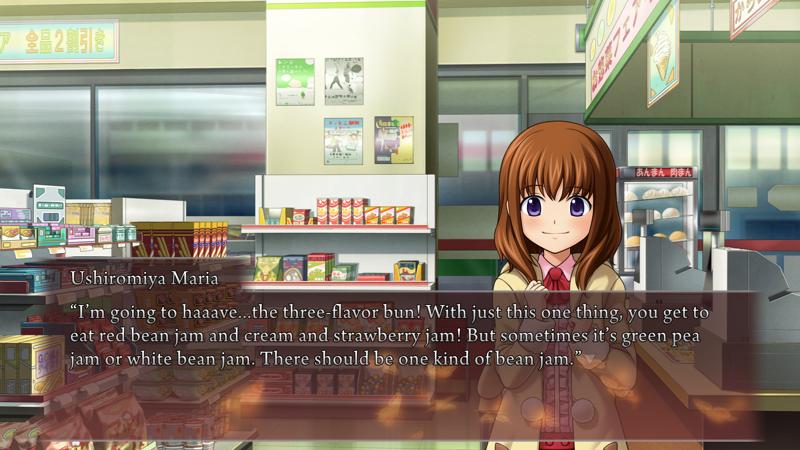
Mmm… anko… damn, I want anpan now. Or daifuku. Why didn’t red beans catch on outside of Asia?
We get a mention of Shotoku Taishi, with an accompanying cultural note:
Shotoku Taishi, or Prince Shotoku (574-622), is the extremely culturally influential regent depicted on the old 5000-yen and 10000-yen Japanese banknotes issued from 1958-1986. His name was used to refer to those notes informally.
In modern Japan, 10000-yen notes are sometimes referred to as “Yukichi” after Fukuzawa Yukichi, the figure on the new 10000-yen banknote that entered circulation in 1984.
Here’s a picture of the relevant 5000 yen note:
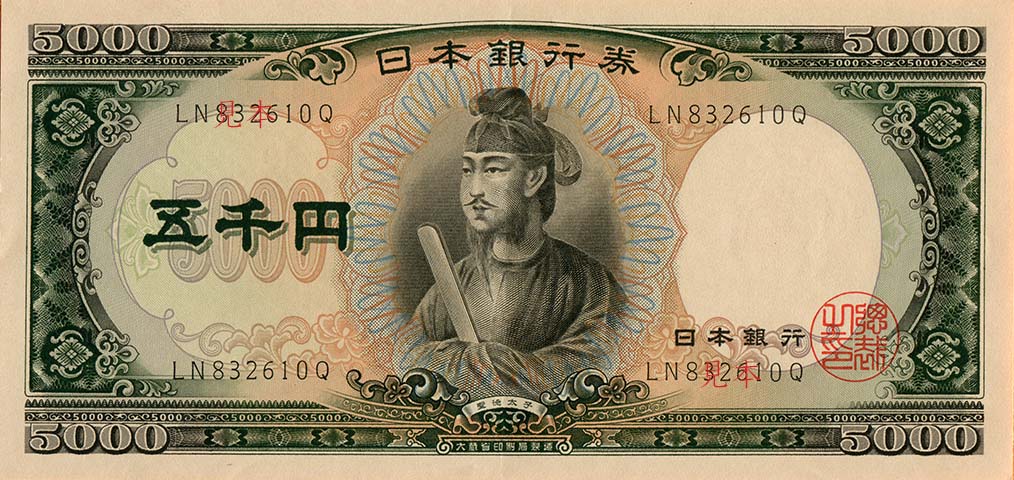
Have to say I appreciate these little notes. I know excessive untranslated terms and translators’ notes are considered kind of cringe these days compared to finding a way to localise it, but I wouldn’t be going out of my way to play a Japanese visual novel if I didn’t want to learn a bit about Japan. It’s not like I could ever get exactly the experience of a native Japanese comiket-goer, even when I’m a lot better at the language.
(Speaking of, I’ve heard a few times that norms around unaccompanied children are very different in Japan than the West. So it wouldn’t be entirely unusual for a young child like Maria to go to the shops.)
Ange remarks again that Sakutaro was a real friend to Maria, not just something she made up to alleviate loneliness. A sign of her magic… and, Maria says, Ange shares the qualifications to become a witch, even though her soul is still ‘slightly bound by gravity’ which will make it a little harder. Would dread to think how heavy my soul must be. The proof is that she is able to feed magic to Maria’s soul, and have these conversations.
Maria: I’m with you after school too, and of course, I’m always by your side even when you return to the dormitory. …It’s just that you never look at me except when you open the diary.
This was in italics so I thought I should quote it. Anyway, Maria starts teaching Ange a little magic. The first step is to look at Maria, a magic spirit, and open and close her eyes for brief periods and visualise her. After practicing this a bit, it’s time to try it with the diary shut.
It occurs to me that this isn’t a dissimilar story of awakening to magic as in Berserk. For example, ordinary people can’t see magic, it’s easier for children, and the process involves closing your eyes and visualising things.
She does so, and silences her various doubts that say this is just something she’s imagining. She has to believe that Maria is ‘definitely there’. It’s hard, though. “Almost like taking a first step off a skyscraper over a sea of lights”, she says, for maximum dramatic irony.
And thus, Ange detaches from the social dogma. That pulsing ‘magic sound’ very quietly appears in the soundtrack.
Ange: …………Maria…onee-chan………!
Unfortunately, she is overheard by three of her classmates and the ritual is interrupted. This time, it’s the humans who drop an ahaha.wav. So Ange hurries away, and we reach the end of the chapter.
Well, well. So.
We’re just setting up the board right now, but there’s some interesting questions that have arisen. We now know that the ‘fragments’ such as Beatrice’s game board do not simulate any part of the world not occupied by one of the central Ushiromiyas—at least for anyone but trespassing witches. This suggests that after each game, the board is reset.
Which… rather suggests that Ange is not from the third game’s fragment, but from the ‘real world’, what I’ve been calling Rokkenjima Prime (but could perhaps be better called Japan Prime or Earth Prime). Unless, of course, we’re still on the game board and Beatrice is showing us this as setup for… some kind of complicated Ange-based attack on Battler’s sense of reality.
Love to have most of the narration be confirmed unreliable!
Anyway, we are reiterating the ideas of magic developed over the last three episodes. To accept magic is to disregard skepticism (‘common sense’) and not close yourself to emotion, at least as a basis. Then you can see the mushi around you. Or, you know, have alters.
I know Ryuukishi07 worked in social services of some kind before making these games, so I imagine he’s had plenty of chances to meet children and adults who have got all sorts of trauma, which means perhaps he’s more likely than most to meet some people who are part of plural systems (whether or not we apply the DID frame). So I’m imagining that he must be channeling that a bit into these portrayals.
Indeed, it seems increasingly central to the theme. Magic and trauma seem to go hand in hand in the world of When They Cry…
Comments
Gabriulio (c628c7d464dd51b208b8ce5446f576d2)
Funnily enough, there is an actual Japanese clothing brand called Auntie Rosa, which Umineko’s is parodying. It’s another example of anachronism, since the real life Auntie Rosa was founded in 1998.
The name of the real-life company is written as アンティローザ, while the Umineko version is written as アンチローザ.
J* (b6d767d2f8ed5d21a44b0e5886680cb9)
Umineko has become one of my all-time favorite narratives and I LOVE watching/reading people go through it because everyone approaches with a different perspective.
One person might hit on the core of one thing super early but be wildly off about something else until much later, and another might do the exact reverse, or find a completely different path of thought that brings them to their own answers.
Without getting too spoilery, Land was changed to Banquet because Ryuukishi07 felt like he wasn’t getting his ideas across to the audience in the way he wanted.
It’s the sort of thing where if you already know the story in its entirety Legend and Turn are actually giving you a lot, but if you’re going in cold you’re not going to process it in the same way and Ryuukishi07 misjudged the distance between those two perspectives.
Rokkenjima Prime is, in fact, the name the fandom settled on for timeline containing the ‘real’ (if such a thing exists) events of Rokkenjima on 10/4-10/5 1986. (Not a spoiler, as the name was used as the EPs were still coming out and people were theorizing about…well pretty much everything.)
Heatth
Finally caught up back to this liveblog! I loved reading it back in the day, but continuing things I once stopped is always hard for me for some reason, so I just decided to read all again from the start. It is very amusing seeing your future notes here and there.
I am really enjoying seeing your theories about magic and witches evolve over the course of these episodes. “Magic is real, yet is fake as shit” mirrors my own thoughts back then, so I am looking forward seeing how this thoughts will evolve.
Branwen (df000686ceb982005344e83be8ca914b)
I was reading through this and a few sections ago you asked if there are explicit gay couples, so I’d just like to mention that there are actually!
There’s one that’s just straight-up lesbian and another that involves a character whose gender identity is not explicitly explained but the relationship is very clearly not straight regardless.
There are also several extremely popular interpretations for other characters/pairings that have a strong basis in canon subtext even if they aren’t ever more than alluded to/hinted at; I rather suspect you’ll arrive at most of those on your own as you keep reading, based on your interpretations so far😁
Anomie
As someone whose main experience of this story has been through the manga, it’s interesting to see the choices Ryukishi07 made when given the chance to retell this story in a different media, I never realized the order of presentation of events was so different between the manga and visual novel. In the manga adaptation of Alliance of the Golden Witch (which I’m taking some time to reread lol) all of the things regarding Ange and her whole Deal and her relationship with Maria are frontloaded, and it’s only after the basic stakes outside the game-world are established (as u will learn when you read more) that we then get into Ange’s past in the direct aftermath of the Rokkenjima incident, and then after that, only around the end of volume 2 of the manga (out of 5) does the story on the game board begin to be woven in